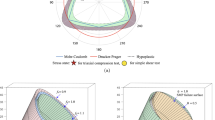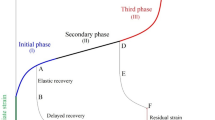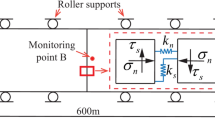Abstract
The paper introduces a novel FEM-DEM local transformation method for accurately simulating crack distribution in damaged rock masses. This method converts crushed and cracked rock mass elements into particle elements, avoiding mesh-dependence in crack extension and improving accuracy without compromising computational efficiency. To validate the feasibility of this method, three methods were used for two-dimensional blasting numerical simulations of organic glass (PMMA): the discrete element method (DEM), the continuum-discontinuum element method (CDEM), and the FEM-DEM local transformation method, and the results were compared with experimental data. The results show that the FEM-DEM local transformation method can accurately characterize the crush zone and crack zone of PMMA plates, and is consistent with the experimental results; while DEM and CDEM can only represent the characteristic morphology of PMMA plate crack zone, they are not accurate enough in depicting the crush zone. A three-dimensional blasting funnel model was established using the FEM-DEM method to determine the relative power of three explosives. Combined numerical simulation and experimental analyses were conducted. Results demonstrate that the FEM-DEM method accurately depicts the shape of the blasting funnel with a small error compared to experimental values, confirming its accuracy. Furthermore, the research shows that the porous ammonium nitrate fuel oil explosive has higher brisance than the modified ammonium nitrate fuel oil explosive, while the emulsified ammonium nitrate fuel oil explosive has lower brisance, consistent with numerical calculations and on-site experiments. The findings provide a reliable numerical method for optimizing blasting parameters and advancing precise blasting technology.








Similar content being viewed by others
Data Availability
Enquiries about data availability should be directed to the authors.
References
Chen H, Wan C, Wang H (2021) Study on blasting crater model of the equivalent spherical charge of bunch-holes(in Chinese). Metal Mine 539(05):36–42
Clark LD, Jones RJ, Howell RC (1971) Blasting mechanics. https://doi.org/10.1007/978-94-011-6501-3 17
Ding C, Yang R, Zheng C (2021) Numerical analysis of deep hole multistage cut blasting of vertical shaft using a continuum-based discrete element method. Arab J Geosci. https://doi.org/10.1007/s12517-021-07425-4
Duan Z, Shi F, Zhang L (2010) Simulation test on distribution and control of blasting fragmentation(in Chinese). Blasting 27(2):5
Fakhimi A, Lanari M (2014) Dem-sph simulation of rock blasting. Comput Geotech 55:158–164
Feng C, Li S, Liu X et al (2014a) A semi-spring and semi-edge combined contact model in cdem and its application to analysis of jiweishan landslide. J Rock Mech Geotech Eng 6(1):26–35. https://doi.org/10.1016/j.jrmge.2013.12.001
Feng C, Li S, Zhou D et al (2014) Numerical analysis of damage and crack process of rock under explosive loading(in Chinese). Chin J Geotech Eng 36(7):9
Feng C, Li S, Liu X (2015) A procedure for transiting fem into dem and its application(in Chinese). Rock Soil Mech 36(4):8
Feng C, Li S, Zheng B et al (2019) Numerical simulation of the complete process of three-dimensional bench blasting in open-pit mines based on the continuum-discontinuum element method(in Chinese). Explosion and Shock Waves 39(2):11
Feng C, Liu X, Lin Q et al (2022) A simple particle-spring method for capturing the continuous-discontinuous processes of brittle materials. Eng Anal Bound Elem 139:221–231
Feng P, Li Y, Wang X (2022) Numerical analysis on two-layer bundle-hole cut blasting with continuous discontinuous elements. Geotech Geol Eng. https://doi.org/10.1007/s10706-022-02198-3
Gao Y (2021) Theoretical calculation and analysis of detonation parameters for porous granular ammonium oil explosives(in Chinese). Coal Mine Blast 39(2):5
Latham JP, Munjiza A, Lu P (1999) Rock fragmentation by blasting—a literature study of research in the 1980’s and 1990’s. Fragblast 3(3):193–212. https://doi.org/10.1080/13855149909408046
Li S, Zhao M, Wang Y et al (2004) A new numerical method for dem–block and particle model. Int J Rock Mech Min Sci 41:414–418. https://doi.org/10.1016/j.ijrmms.2004.03.076
Li S, Wang J, Liu B et al (2007) Analysis of critical excavation depth for a jointed rock slope using a face-to-face discrete element method. Rock Mech Rock Eng 40(4):331–348. https://doi.org/10.1007/s00603-006-0084-9
Li J, Feng C, Zhu X et al (2022) Analysis of the coal fluidization mining process with the continuous-discontinuous coupled particle-block method. Geofluids. https://doi.org/10.1155/2022/7001654
Li Y, Feng C, Ding C et al (2022) A novel continuous-discontinuous multifield numerical model for rock blasting. Appl Sci. https://doi.org/10.3390/app122111123
Murphy N, Ali M, Ivankovic A (2006) Dynamic crack bifurcation in pmma. Eng Fract Mech 73(16):2569–2587
Rabczuk T, Belytschko T (2007) A three-dimensional large deformation meshfree method for arbitrary evolving cracks. Comput Methods Appl Mech Eng 196(29):2777–2799. https://doi.org/10.1016/j.cma.2006.06.020
Ren H, Zhuang X, Rabczuk T (2017) Dual-horizon peridynamics: a stable solution to varying horizons. Comput Methods Appl Mech Eng 318:762–782. https://doi.org/10.1016/j.cma.2016.12.031
Wang Y, Zhao M, Shihai LI et al (2005) Stochastic structural model of rock and soil aggregates by continuum-based discrete element method. Sci Chin Tech Sci. https://doi.org/10.1360/04zze13
Wang H, Bai C, Feng C et al (2019) An efficient cdem-based method to calculate full-scale fragment fifield of warhead. Int J Impact Eng 133:103–331. https://doi.org/10.1016/j.ijimpeng.2019.103331
Wang B, Li H, Shao Z et al (2021) Investigating the mechanism of rock fracturing induced by high-pressure gas blasting with a hybrid continuum-discontinuum method. Comput Geotech 140:104–445. https://doi.org/10.1016/j.compgeo.2021.104445
Wang H, Yu A, Feng C et al (2022) An efficient cdem-based method to calculate full time-space natural fragment field of shell-bearing explosives. Int J Impact Eng 161:104–099
Wilson WH (1987) An experimental and theoretical analysis of stress wave and gas pressure effects in bench-blasting. Univ Maryland Coll Park. https://doi.org/10.1007/978-94-011-6501-317
Yang R, Ding C, Wang Y et al (2016) Action-effect study of medium under loading of explosion stress wave and explosion gas(in Chinese). Chin J Rock Mech Eng 35(A02):6
Yang J, Shi C, Wang S et al (2019) Numerical simulation validation study of rock mass blasting destruction effect particle flow(in Chinese). J Disaster Prev Mitig Eng. https://doi.org/10.13409/j.cnki.jdpme.2019.02.004
Yue Z, Yang L, Wang Y (2013) Experimental study of crack propagation in polymethyl methacrylate material with double holes under the directional controlled blasting. Fat Fract Eng Mater Struct 36(6):827–833. https://doi.org/10.1016/j.engfracmech.2006.06.008
Zeng Q, Hu Z, Liu K (2021) Experiment and numerical simulation of blasting crater under high in-situ stress(in Chinese). Metal Mine 536(02):36–40
Zhang Y, Zhuang X (2018) Cracking elements: a self-propagating strong discontinuity embedded approach for quasi-brittle fracture. Finite Elem Anal Des 144:84–100. https://doi.org/10.1016/j.fifinel.2017.10.007
Zhang Y, Zhuang X (2019) Cracking elements method for dynamic brittle fracture. Theoret Appl Fract Mech 102:1–9
Zhang Y, Lackner R, Zeiml M et al (2015) Strong discontinuity embedded approach with standard sos formulation: Element formulation, energy-based crack-tracking strategy, and validations. Comput Methods Appl Mech Eng 287:335–366. https://doi.org/10.1016/j.cma.2015.02.001
Zhang Y, Huang J, Yuan Y et al (2021) Cracking elements method with a dissipation-based arc-length approach. Finite Elem Anal Des 195:103–573. https://doi.org/10.1016/j.fifinel.2021.103573
Zheng B, Feng C, Song J et al (2015) Numerical simulation study on the influence of explosive consumption on the fragmentation of hematite blasting(in Chinese). Blasting 32(3):8
Zhu X, Feng C, Cheng P et al (2021) A novel three-dimensional hydraulic fracturing model based on continuum-discontinuum element method. Comput Methods Appl Mech Eng 383:113–887. https://doi.org/10.1016/j.cma.2021.113887
Acknowledgements
The authors gratefully acknowledge the financial support by the National Natural Science Foundation of China (NSFC) (52178324).
Funding
This study was supported by the National Natural Science Foundation of China (NSFC) (52178324).
Author information
Authors and Affiliations
Corresponding author
Ethics declarations
Conflict of interest
The authors declare no conflict of interest of this work.
Additional information
Publisher's Note
Springer Nature remains neutral with regard to jurisdictional claims in published maps and institutional affiliations.
Rights and permissions
Springer Nature or its licensor (e.g. a society or other partner) holds exclusive rights to this article under a publishing agreement with the author(s) or other rightsholder(s); author self-archiving of the accepted manuscript version of this article is solely governed by the terms of such publishing agreement and applicable law.
About this article
Cite this article
Cao, R., Li, Y., Feng, C. et al. Study on the Damage Effects of Explosive Media Based on FEM-DEM Local Adaptive Transformation. Geotech Geol Eng 42, 339–350 (2024). https://doi.org/10.1007/s10706-023-02575-6
Received:
Accepted:
Published:
Issue Date:
DOI: https://doi.org/10.1007/s10706-023-02575-6




